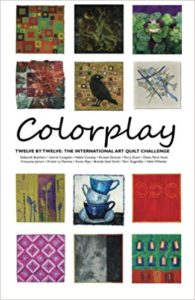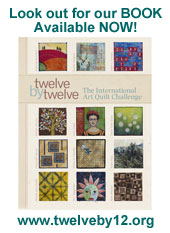
Quilts are inherently mathy with their geometric shapes, and blocks that are fractions in visual form. Even measuring patches requires math. After a few sketches though, I decided that traditional quilt blocks, or even tessellations and more modern treatments were too obvious. Finally, the phrase “You do the math” appealed to my ironic side that Terry says I seem to gravitate towards. It begged for some sort of comparison or statistics. For it to be meaningful to me, I figured I should look at women’s issues, or something close to home. It was in the writings of Jared Diamond that I ultimately found my theme.
In his book Collapse, Diamond refers to Thomas Malthus, an English economist and demographer, who is famous for the dilemma explained in his 1798 Essay on Population,
“The power of population is infinitely greater than the power in the earth to produce subsistence for man. Population unchecked, increases in geometrical ratio. Subsistence increases only in arithmetical ratio. A slight acquaintance with numbers will show the immensity of the first power in comparison of the second.”
I searched the internet for numbers to support Malthus' dilemma so that I might create a fabric chart to express it. My feeble scratch at the surface of this issue was hardly conclusive, but it provided lots of off-topic food for thought (pun intended). Irregardless of whether Malthus' Dilemma is proving itself out or not, the comparison of geometrical and arithmetical growth is in itself mathematical and thusly fits the challenge.

Using numbers from the UN's statistics website and the help of my Excel savvy husband, I drafted a chart showing the historic (since 1950) and projected population growth of the less developed countries in the world (that dramatic uphill curve growing towards an estimated leveling off near 8 billion people by 2050) and the growth of the more developed countries as shown in the thinner section between 1 and 1.5 billion people. I pieced this chart with feed sack fabrics for the obvious reason that it was appropriate to the discussion of feeding the world. Over these geometric curves are embroidered lines showing the arithmetical growth of major grain yields from 1950 to 2005. I left the ends hanging loose because there is no way to accurately forecast future grain production and possible breakthroughs. The quilt is bordered with small beads representing rice and corn.
Long story short, this chart quilt (and all charts are mathematical in basis) of a mathematical hypothesis is my take on the theme "Mathematics."



13 comments:
I only had to read the first few sentences to know this was your piece Kristin. Working the feedbags into the equation was so clever, and the message is so meaningful and timely.
Kristin, I love how you executed this quilt and am impressed with the thought and ideas that you have conveyed. I love old cloth feedbags. They are such a part of my personal history so this piece just jumps out at me on a very personal level.
Wonderful! I love how you used the basic idea of Mathematics to express something you feel passionate about and is meaningful to the entire planet. As always, each little detail captivates me -- nothing is by accident. Beautiful.
Yes, I agree with all of that too! I always enjoy how you delve deep under a topic to find a way to illustrate it in a meaningful and multi-layered way, and still create a piece that is also very attractive to look at. The feedsacks are just perfect.
Wow. You really did do some research. It's a very serious topic. I love that you represented it in such a straight forward manner. I especially love the corn and rice border. Did you embroider those words? I can't quite tell.
Amazing piece. You always, as Diane said, delve deep into a topic to find your inspiration. Your sense of design is so strong that you find the inherent visual possibilities in even very cerebral ideas. Your work always shows a very intelligent mind at work, as well as visual delight.
I alwasy wondered what feedsack actually looked like - where do you get them? I was boggle minded when I read your earlier post as to how you were going to get all that information into 12 x 12 - what a good idea to represent a representation ( if you see what I mean!). I like the symbolism of the border a lot and of course the social message is my kind of thing too.
That is an extraordinary amount of information to represent in twelve square inches and you have done it so very well. The feedsack was a touch of brilliance.
You know what I just love? Those little rectangles formed by the quilting lines. Maybe they gave me a little resting place in amongst the enormity of the ideas.
Thanks everyone! I'm feeling very humbled by all the fabulous and varied interpretations of the theme this time around.
Deborah, unlike Kirsty, I am NOT insane, and did not embroider the text or numbers. They are written with a fine point Micron pen.
Helen, I've had those feed sacks for years. It just underlines why I can purge power strips, clothes, tchotchkis, electronic devices and toys when moving house, but NOT fabric! It all has to come with me -- no matter how heavy it is! I bought several feed sacks at a quilt fair in Virginia when we lived there over a dozen years ago. Many places with traditional American antique-y stuff will have some feed sacks and vintage orphan quilt blocks. I also have a few little printed bags based on feed sacks that I've kept from Christmas presents and other cookie mix kind of gifts. I didn't use them here, but they were auditioned.
Kirsty, I'm glad you like those rectangles. I'm rather pleased myself with how the grid necessary to show the relationship between the years and the numbers also works so perfectly as quilting.
Wow Kristin, your thought process always astounds me. I am just stunned at all the elements that make this quilt and the meanings behind them.
So much thought went into your quilt, as usual. I hope one day I can see all these pieces in real life.
It is so nice to read how you came to your creation. I like it very much. It is almost a graphic design and it has a bit of economy in it too.
Post a Comment